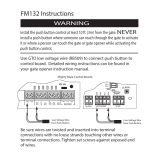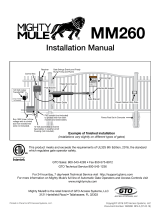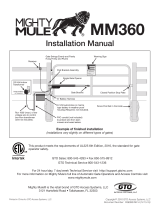Page is loading ...

PHOTOELECTRIC
DUAL BEAM DETECTOR
Receiver
Connection Terminals
Indicators
Wiring Knockout
Vertical
Alignment
Screw
Lens
Cover
Locking Screw
Response Time
Adjustment
(only for receiver)
Signal Level Test
Points
Tamper Switch
Sight Hole
Horizon-
tal Angle
Adjusting
Bracket
PARTS DESCRIPTION
INTERNAL VIEW OF RECEIVER
COVER
Owners Manual
R4222
GTO • 3121 Hartseld Road • Tallahassee, Florida 32303 • (800) 543-4283 • www.gtoinc.com
Technical Service (800) 543-1236
©2007 GTO, Inc.
For use with use with all GTO/PRO and Mighty Mule AC and DC powered gate operators.
For more information on GTO’s full line of automatic gate openers and access controls visit our website at www.gtoinc.com
R4222 Rev. 11/6/07
Printed in China for GTO, Inc.
The GTO/PRO Photoelectric Dual Beam Detector uses dual beam and through beam technology to reduce
false detections when detecting obstructions. When the beams detect the presence of a moving object,
the detection will cause the gate(s) to stop and reverse to the fully open position. As long as the beam is
obstructed the gate(s) will remain open. Not compatible with solar powered gate operators.

2
Mounting Cautions
Where obstructions (plants, fences, etc.)
are between the receiver and the sender.
Where the mounting
surface is unstable.
Where sunlight and headlights shine
directly into the front of the receiver.
Mounting Height
Sensing Area
Spread of Beam
Beam Alignment
Range
Horizontally 180°
The optical axis can be fine tune
adjusted in horizontal and
vertical direction.
Up/Down Direction
20° (±10° )
Installation Overview
Vehicular Gate
Exterior placement
of Photo Beams
(placed outside of path of gate)
Interior placement
of Photo Beams
(placed outside of path of gate)
Be sure that the optical axis is never obstructed. (The optical axis
is both the vertical and horizontal range of detection, or beam,
between the transmitter and receiver)
Do not mount the detector in the following conditions:
When using more than one set make
sure to alternate the transmitters
and detectors as above.
Transmitter
Receiver
Transmitter
Receiver
Transmitter
Transmitter
Receiver
Receiver
Diagram illustrates correct placement of photo beams in relation to the gate.

3
Pole Mounting
1. Feed the wire through the pole. 2. Remove the Photo Beam cover.
(as shown above in step1)
3. Fix the base plate on the bracket.
Back to Back Installation
(Refer to the gure above)
Pole
Mounting Plate
Fixed
Regular Ring
Feed the Wire
Through The Pole
Receiver
Receiver
Receiver
Wiring Location
In Wall
Receiver
Screw Hole
Screw Hole
Wiring Hole
BACK OF COVER
1. Loosen the cover-
holding screw but DO NOT
REMOVE (NOTE: BE
CAREFUL NOT TO DROP
THE NUT THAT
ACCOMPANIES SCREW).
Now remove the outer cover
slowly so nut doesn’t fall.
2. Remove the rubber
knockout and use the
screw holes to mount
the unit.
3. Remove the rubber
knock-out and pull the
wire through.
4. Mount the detector
on the wall and run the
wire through the wiring
location in the wall.
Wall Mounting
NOTE: Pole may be purchased at your local hardware store.

4
Correct Wrong Wrong
Wire
Terminal
Block
Terminal
Block
Terminal
Block
Wire Wire
• Wire with 16awg minimum (RB509)
• 300 ft (91.4m) max length
• Be sure to capture the wire ends under
the wire clamp plates.
• Avoid frayed ends on wires that might
produce a short circuit.
• Be careful not to overtighten the screws
as this may strip the threads in the plastic
The diagrams below represent the terminal strips on the receiver and transmitter and can be used for
reference for connections.
Receiver
Connecting wires to the terminals (normally open wiring).
Connecting Photo Beams to GTO/PRO and
Mighty Mule Control Boards
Terminal Strip Identification
Make sure the power switch to
the opener is turned off before
connecting safety device wiring
to the terminal blocks. Unplug-
ging the transformer does not
turn power to the opener OFF.
NOTE: DO NOT use with solar panels.
POWER
TAMPER
SWITCH
TAMPER
SWITCH
COM
N.C.
N.O.
Wiring Terminals
RECEIVER
1 2 3 4 5 6 7
1 2 3 4 5 6 7
POWER
NOT USED
Wiring Terminals
TRANSMITTER

5
RECEIVER
ALM
GTO RCVR.
COM
GRN
BLK
RED
CYCLE
SAFETY
EXIT
SHADOW
OPEN
EDGE
COM
CONTROL INPUTS
CLOSE
EDGE
+ -
POWER
1 2 7
3 6
FREE
4 5
+ -
POWER
1 2 7
3 6
ALARM
4 5
INTERIOR TOP OF
RECEIVER
INTERIOR TOP OF
TRANSMIT TER
12 Volt Battery with
Dual Spade Connectors
or other 12Vdc source
Transmitter/Receiver Connections
Double Spade
Tongue Connectors
Wires from Photo Beams
Connections for
PRO 2000XL, PRO 3000, PRO 3000XL,
PRO 4000, PRO 4000XL, MM 500
Control Boards
To+ Pos Terminal of Battery
To - Neg Terminal of Battery
1. Connect 1 and 2 power
terminals of the transmitter to the
1 and 2 power terminals of the
receiver.
2. Connect 1 and 2 power
terminals of the Receiver OR
Transmitter to the battery.
3. Connect 3 and 5 terminals
of the receiver to the COM and
SAFETY terminals on the control
board.
Wiring the Photo Beams to GTO/PRO and
Mighty Mule Gen 3 (blue) or green Gate Opener
Control Boards. (models listed below)

6
CHARGING
POWER
AUX OUT
SOLAR
PANEL
18VAC
RECR
GRN
BLK
RED
EXIT
SAFETY
EDGE
CYCLE
COMMON
LINK
+ -
POWER
1 2 7
3 6
FREE
4 5
+ -
POWER
1 2 7
3 6
ALARM
4 5
INTERIOR TOP OF
RECEIVER
INTERIOR TOP OF
TRANSMITTER
12 Volt Battery with
Dual Spade Connectors
or other 12Vdc source
Transmitter/Receiver Connections
Double Spade
Tongue Connectors
Wires from Photo Beams
To+ Pos Terminal of Battery
To - Neg Terminal of Battery
Wiring the Photo Beams to Mighty Mule
FM-350 Gate Opener Control Board.
1. Connect 1 and 2 power
terminals of the transmitter to the
1 and 2 power terminals of the
receiver.
2. Connect 1 and 2 power
terminals of the Receiver OR
Transmitter to the battery.
3. Connect 3 and 5 terminals of
the receiver to the COMMON and
SAFETY terminals on the control
board.

7
Wiring the Photo Beams to GTO/PRO GP-SL100 and
GP-SW100 Gate Opener Control Boards.
+ -
POWER
1 2 7
3 6
FREE
4 5
+ -
POWER
1 2 7
3 6
ALARM
4 5
INTERIOR TOP OF
RECEIVER
INTERIOR TOP OF
TRANSMITTER
12 Volt Battery with
Dual Spade Connectors
or other 12Vdc source
Transmitter/Receiver Connections
To+ Pos Terminal of Battery
To - Neg Terminal of Battery
Double Spade
Tongue Connectors
Wires from Photo Beams
COM
COM
COM
CYCLE
SAFETY
SHADOW
OPEN
CLOSE
STOP
OPEN
EDGE
CLOSE
EDGE
RUNNING
CLOSED
LED10
LED09
W1
CUT TO USE
3 BUTTON
STATION
CYCLE
SAFETY
SHADO W
OPEN
EDGE
CLOSE
EDGE
OPEN
CLOSE
STOP
COM COM COM
1. Connect 1 and 2 power
terminals of the transmitter to the
1 and 2 power terminals of the
receiver.
2. Connect 1 and 2 power
terminals of the Receiver OR
Transmitter to the battery.
3. Connect 3 and 5 terminals
of the receiver to the COM and
SAFETY terminals on the control
board.

8
ON
ALARM ACCESSORY RCVR
SEQ1
SEQ2
LEARN
BLU
ORG
WHT
GRN
R B G
+ -
POWER
1 2 7
3 6
FREE
4 5
+ -
POWER
1 2 7
3 6
ALARM
4 5
INTERIOR TOP OF
RECEIVER
INTERIOR TOP OF
TRANSMIT TER
Transmitter/Receiver Connections
To+ Pos Terminal of Battery
To - Neg Terminal of Battery
Wires from Photo Beams
12 Volt Battery with
Dual Spade Connectors
or other 12Vdc source
Double Spade
Tongue Connectors
Wiring the Photo Beams to GTO/PRO, FM700/702
PRO-SL1000/2000 and PRO-SW1000/2000
Gate Opener Control Boards.
1. Connect 1 and 2 power
terminals of the transmitter to the
1 and 2 power terminals of the
receiver.
2. Connect 1 and 2 power
terminals of the Receiver OR
Transmitter to the battery.
3. Connect 3 and 5 terminals of
the receiver to the GRN and ORG
terminals on the control board.

9
R
eceiver
Receiver
Receiver
Receiver
Viewfinder
(close-up)
Viewfinder
(location)
2. Adjust the horizontal pivot, and the vertical adjustment screw using the built-in viewer. Look through the
viewnder on either side and adjust to put the oppposite sensor in the middle of the cross-hairs in the view
nder. The GOOD LED should be on. (Adjust the light axis until the indication lamp is on).
• The brighter the Green LEVEL LED, the more precise the alignment of the beams.
R
eceiver
1
2
3
4
5
Beam Interruption
Time Adjustment
Receiver
Vertical
Adjustment Screw
To Raise To Lower
Beam Interruption Time Adjustment
Adjusts the amount of time between the beam being broken and
the normally open relay closing. Adjust time adjustment dial from
(1) detecting fast moving objects to (5) detecting slow moving
objects depending on your type of application and environment.
1. Remove the RECEIVER and TRANSMITTER covers (Be careful not to drop screw and nut) and make sure
power is connected.
Beam Alignment
Adjusting Optical Axis with the Viewfinder
If you have a voltmeter, the best method of adjusting the opti-
cal axis is to measure the signal level at the test probe points.
1. Insert the voltmeter probes into the test points on the side
of the receiver.
2. Adjust the horizontal angle and vertical angle until the
voltage is at maximum.
3. If a voltage of 1.2v or above cannot be reached, the
transmitter and/or receiver should be readjusted.
Adjusting Optical Axis with a Voltmeter
• GOOD LED (green) Use when
adjusting beam alignment. ON when
beams are aligned, OFF when beams are
not aligned. (Refer to operation instructions)
• LEVEL LED (green) ON indicates
received signal. Brightness varies,
depending on how well beam is aligned.
• ALARM LED (red) ON indicates beam
blocked. Use when setting response time.
(Refer to operation instructions)
GOOD LEVEL ALARM
RECEIVER INDICATORS
• POWER LED (green)
ON when light beam
is transmitting.
POWER
TRANSMITTER INDICATOR
1
Fast
Moving Objects
5
Slow
Moving Objects
Voltmeter
Test Points
for Voltmeter
Horizontal Adjusting
Bracket

Symptom Possible Cause Remedy
Transmitter LED does not light. Improper voltage supplied. Check the power supply and wiring.
Receiver LED does not light. Improper voltage supplied. Check the power supply and wiring.
Alarm LED does not light,
even when beams are blocked.
1. Beams reect to the receiver
by other objects.
2. Both beams are not blocked
simultaneously.
3. Beam interruption time is too short.
1. Remove the reecting object or change
optical axis direction.
2. Block both beams.
3. Increase beam interruption time
adjustment.
When the beams are blocked, the
receiver LED light is ON, but not alarm.
1. Wiring is short circuited.
2. Wiring connection is not good.
Check wiring and connection spot.
The alarm indication lamp of receiver is
always on.
1. Optical axis is not properly adjusted.
2. There are obstructions between the
transmitter and the receiver.
3. The outer covers are dirty.
1. Adjust the optical axis.
2. Remove the obstructions.
3. Clean with window cleaner and a
soft cloth.
Intermittent Alarm (detection)
*If your experiencing false detections
then increase the time adjustment by 1
increment at a time until the photo beam
functions as desired.
1. Bad wiring.
2. Fluctuating power supply / voltage.
3. Intermittent blockage between the
transmitter and the receiver.
4. The receiver or transmitter is unstable.
5. Blocked by other moving objects.
6. Beam interruption time out of adjustment.
1. Check wiring.
2. Check the power supply.
3. Remove the obstruction or relocate.
4. Fix the mounting.
5. Adjust the optical axis.
6. Adjust interruption time or change
installation position.
MODEL R4222
Detection Method Infrared photoelectric
Range Outdoor 98.4 ft (30m)
Indoor 295.2 ft (90m)
Beam Characteristics Pulsed infrared dual beams
Response Time 50~700msec (selectable)
Power Input DC12.5~24V / AC11~18V
Current Consumption 40mA max
Output Pulse Duration 2Sec (±1)nominal
Alarm Output Form C relay (AC/DC 30V 0.5A max)
Tamper Switch N.O. contact is open when cover is removed (transmitter and reciever)
Operating Temperature -13˚F (-25˚C)~131˚F (55˚C)
Environment Humidity 95% max
Alignment Angle 20˚±10˚ vertical, ±90˚ horizontal
Mounting Wall or pole
Weight .66lbs (300g) Both transmitter and receiver
Appearance PC Resin (Black)
Condition Indication
Transmitter
Transmitting GOOD LED is ON
Receiver
Beam Not Blocked GOOD and LEVEL LEDs are ON
Beam Blocked ALARM LED is ON
VERIFY CORRECT OPERATION
TROUBLESHOOTING
SPECIFICATIONS
After installation, conrm
correct operation by suitable
walking tests. Refer to the
appropriate LED indicator
during the walking test and
ensure the gate opener
operates in the correct manner.
For optimal
efciency, wipe
the outer cover
frequently with a
soft, damp cloth.
Not compatible
with Solar Panels.
/









